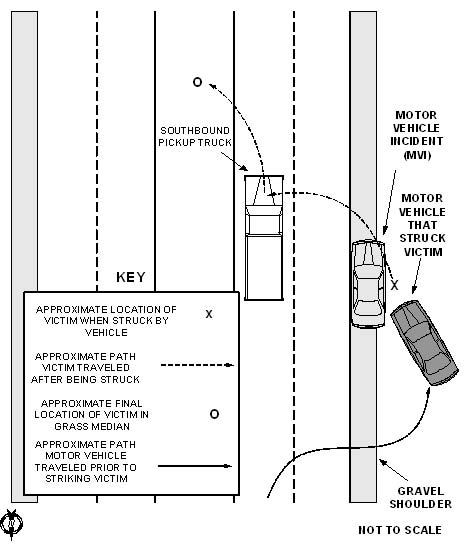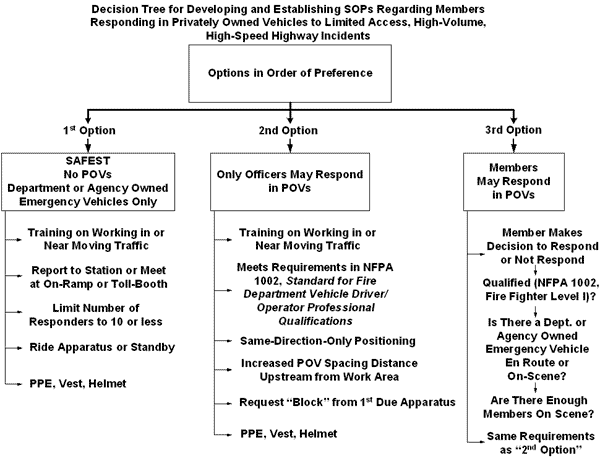

Volunteer Fire Fighter Dies After Being Struck by Motor Vehicle on Interstate Highway - Mississippi
SUMMARY
On March 20, 2002, a 19-year-old male volunteer fire fighter (victim) died after he was struck by a car along an interstate highway. The victim responded to a motor vehicle incident located on the shoulder of the outer southbound lane. While on the shoulder of the outer lane, he was struck by a car which threw him into traffic where he was struck by a southbound pickup truck. He landed on the grassy median. The victim was transported to an area hospital where he was pronounced dead.
The NIOSH investigator concluded that, to minimize the risk of similar incidents, fire departments should
INTRODUCTION
On March 20, 2002, a 19-year-old male volunteer fire fighter (victim) died after he was struck by a car along an interstate highway. On March 22, 2002, the U.S. Fire Administration (USFA) notified the National Institute for Occupational Safety and Health of this fatality. On April 23, 2002, a safety and occupational health specialist from the NIOSH Fire Fighter Fatality Investigation and Prevention Program investigated this incident. The NIOSH investigator met with the Chief of the department, visited the incident site, and interviewed the fire fighter that had responded to the initial motor vehicle incident. A phone interview was conducted with a paramedic that had transported the victim. The investigator reviewed the State police report, witness statements, emergency medical run report, medical examiner’s report, coroner’s report, victim’s training records, and the department’s standard operating procedures.
Fire Department. The volunteer fire department has 14 fire fighters and serves a population of approximately 6,000 in an area of about 41 square miles.
Training and Experience. The victim had completed 72 hours of in-house training covering 24 different topics and had been a volunteer fire fighter for 1 year. The victim was scheduled to attend the state volunteer fire fighter certification program.
The department requires all new members to serve a 3-month probationary period and to complete, at a minimum, the state volunteer fire fighter certification program within 1 year of becoming a member.
Equipment and Personnel. The victim responded in his privately owned vehicle (POV - [no emergency lighting]) and was wearing blue jeans and a light-colored shirt at the scene of a motor vehicle incident. Engine 2 (Driver/Operator) responded to the initial motor vehicle incident and arrived on the scene approximately 1 minute after the victim had been struck by a motor vehicle. A Sheriff’s Deputy was on the scene and radioed Central Dispatch to report the motor vehicle incident involving the victim. Rescue 5 (two paramedics from a mutual-aid department within the county) self-dispatched after the victim was struck by the motor vehicle.
Weather and Road Conditions. The incident occurred at approximately 1450 hours with heavy rain. The incident occurred on an interstate highway in a construction zone that had an uneven asphalt/blacktop surface. The outer (slow) lane had a higher surface than the inner (passing) lane. Note: The NIOSH investigator was unable to determine the construction signs present at the time of the incident. The interstate highway had a gravel shoulder at the time of the incident. The posted speed limit was 70 mph.
INVESTIGATION
On March 20, 2002, at 1445 hours, Central Dispatch dispatched the volunteer fire department for a motor vehicle incident in the southbound lane of the interstate. Note: This was a single motor vehicle incident with no injuries. Engine 2 responded from the station at approximately 1445 hours with a driver/operator. The victim responded in his privately owned vehicle (POV). The driver/operator of Engine 2, heading north on the interstate, radioed the victim the location (mile marker 112) of the motor vehicle incident. The driver/operator then radioed the victim that he was going to continue with Engine 2 to the next exit and would come back in the southbound lane. The victim approached the scene in the northbound lane. He drove over the grass median and over the southbound lane, and he parked his POV on the shoulder of the outer southbound lane directly in front of the single motor vehicle incident. While on the scene, a second single motor vehicle incident occurred approximately 150 yards to the south of the initial motor vehicle incident. The victim then walked along the outside shoulder and approached the motor vehicle on the passenger side to assess the driver’s condition. The victim radioed the driver of Engine 2 to report that there were no major injuries and to tell him to slow his response. Approximately 2 minutes later, a motorist approaching the scene attempted to move from the slow lane to the passing lane when they lost control of their vehicle. The car skidded off the road and traveled along the outer shoulder of the southbound lane and struck the victim. The impact threw the victim into passing traffic where he was struck by a southbound pickup truck that threw him onto the grassy median (Diagram). The Sheriff’s Deputy (now on the scene) radioed Central Dispatch to report a motor vehicle incident and a fire fighter down. Rescue 5 self-dispatched to the scene. The driver/operator of Engine 2 drove past the scene and staged the apparatus on the outer shoulder. The driver/operator of Engine 2 was informed by a career fire fighter, who had stopped to assist, that there was a victim in the median and the driver involved in the second motor vehicle incident was complaining of pain from his injuries. The driver/operator of Engine 2 assisted the driver who was injured in the second motor vehicle incident. Rescue 5 arrived on the scene and attended to the victim. The victim was unresponsive with no pulse and no respirations. The paramedics began administering cardiopulmonary resuscitation (CPR) on the victim. A private ambulance arrived on the scene and transported him to a local hospital where he was pronounced dead.
CAUSE OF DEATH
The coroner’s report listed the cause of death as craniocerebral trauma.
RECOMMENDATIONS/DISCUSSION
Recommendation #1: Fire departments should develop, implement, and enforce standard operating procedures (SOPs) regarding emergency operations for highway incidents. 1-8
Discussion: Fire fighters operating at an incident on a highway are in danger of being struck by oncoming motor vehicles. SOPs can help establish proper traffic control measures when operating at an incident scene. SOPs should include but not be limited to the following: incident command, apparatus positioning, lane closures, methods to establish a secure work area, wearing appropriate protective clothing at all times, clearing traffic lanes, and releasing the incident scene back to normal operation.
SOPs should include specific procedures to follow at high-volume, limited access highway operations. An example of a standard operating procedure (SOP) is available for fire departments at www.respondersafety.com. This sample SOP provides specific information for high-volume, limited access highway operations.
Recommendation #2: Fire departments should ensure that fire fighters establish a protected work area before safely turning their attention to the emergency. 7, 9
Discussion: As stated in the Pumping apparatus driver/operator handbook, "some of the most dangerous scenarios faced by fire fighters are operations on highways, interstates, turnpikes, and other busy roadways. Fire apparatus should be placed between the flow of traffic and the fire fighters working on the incident to act as a shield. The apparatus should be parked on an angle so that the operator is protected by the tailboard. Front wheels should be turned away from the fire fighters working highway incidents so that the apparatus will not be driven into them if struck from behind. Also consider parking additional apparatus 150 to 200 feet behind the shielding apparatus to act as an additional barrier between fire fighters and the flow of traffic." The positioning of apparatus (as a shield) is referred to as a "block" that creates a protected area known as the "shadow." For limited-access, high-volume highway incidents, the first arriving apparatus (preferably a ladder truck or other large apparatus) establishes the “block” by positioning the apparatus upstream (the direction that traffic is traveling from as the vehicles approach the scene) from the incident, providing a "shadow" where emergency personnel can safely work.
Recommendation #3: Fire departments should consider limiting or restricting the response of their members in their privately owned vehicles (POVs) to high-volume limited access highway incidents. 1-7
Discussion:NFPA 1500, 6.2.3 states that "the fire department shall enact specific rules and regulations pertaining to the use of private vehicles for emergency response." NFPA 1500, 6.2.3.1 states that "these rules and regulations shall be at least equal to the provisions regulating the operation of fire department vehicles." High-volume limited access highways include expressways, toll ways, and multi-lane roadways within the fire department response area. Fire fighters responding to limited-access highway incidents in their privately owned vehicles (POVs) may be ill-equipped to protect themselves or the civilians they are serving from oncoming traffic (may not be able to provide adequate protection from approaching vehicles). High-volume limited access highways pose additional hazards (e.g., higher speed limits, larger vehicles, and a higher number of vehicles). Responding in a privately owned vehicle may not afford fire fighters the means to carry all of the necessary equipment (e.g., personal protective equipment, high-visibility vests, flags, cones, specialized rescue tools) to operate in or near moving traffic. Fire department or agency emergency vehicles can carry all of the required equipment and provide a means to block the scene, providing a safe work zone. A decision tree3 (Attachment) can be used in the development of department SOPs when addressing whether to allow members to respond in privately owned vehicles to limited access, high-volume, high-speed highway incidents.
Recommendation #4: Fire departments should develop and implement pre-incident plans regarding traffic control for emergency service incidents. 1, 2
Discussion: The need to identify areas that have higher rates of incidents (e.g., motor vehicle crashes) should be evaluated so that standard operating procedures for emergency personnel can be tailored to the needs of particular sites (e.g., blind curves or corners, hills or sloped areas, and high-traffic areas). Fire departments can work with local highway departments and local law enforcement agencies to identify problem areas and devise solutions to those problem areas in advance. Experience and knowledge of local territory will help in creating pre-incident plans and in the establishment of standard operating procedures to make the response more efficient and safer for emergency responders.
REFERENCES
INVESTIGATOR INFORMATION
This incident was investigated by Mark McFall, Safety and Occupational Health Specialist, Trauma Investigations Section, Surveillance and Field Investigations Branch, Division of Safety Research, NIOSH.

Diagram. Aerial View of Incident Scene
ATTACHMENT

Return to Fire Fighter Homepage
This page was last updated on 04/03/03